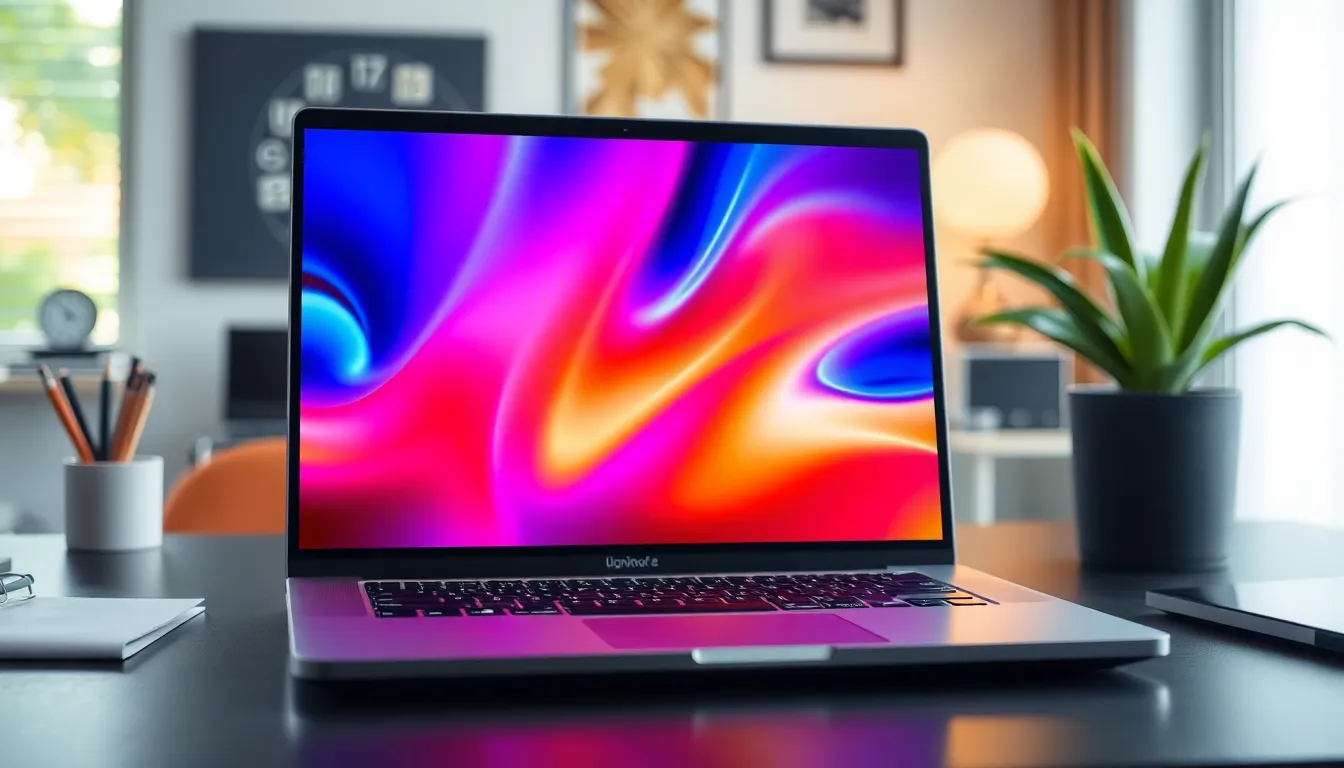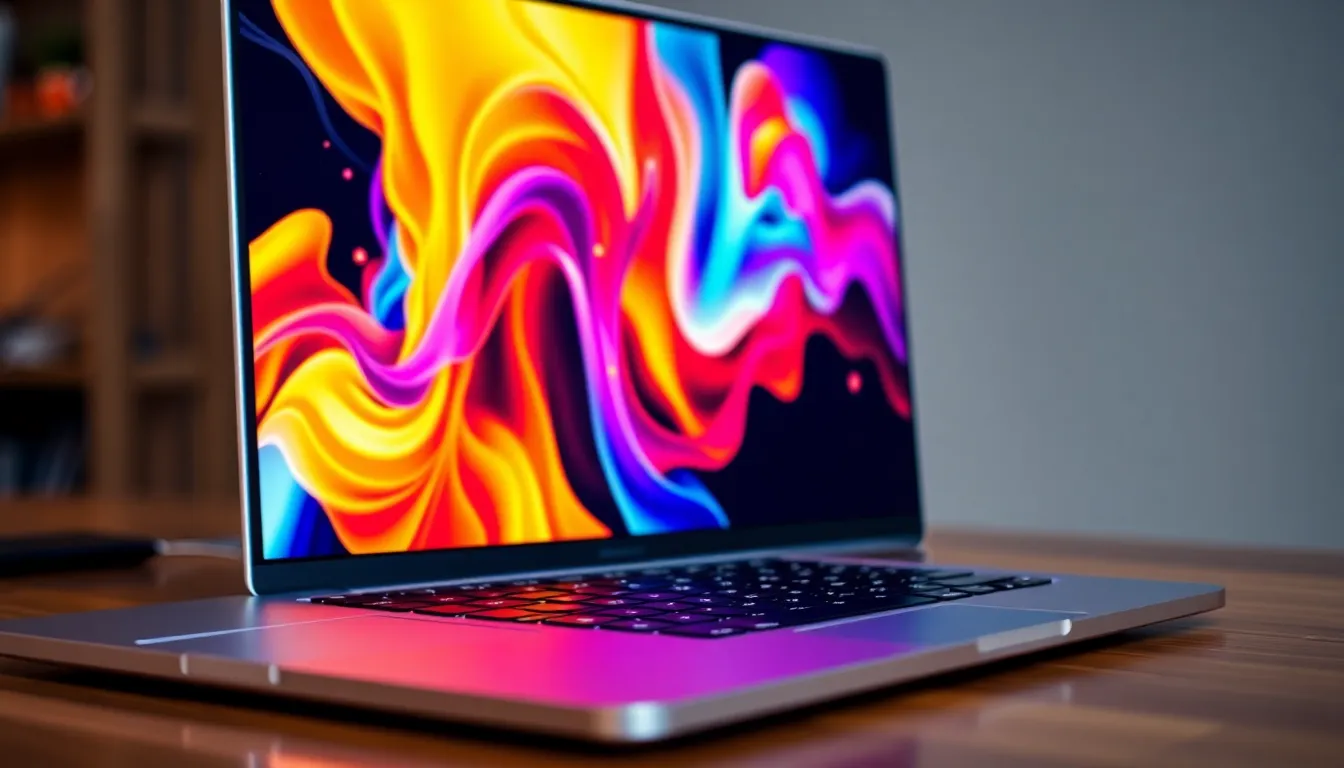Table of Contents
ToggleChoosing the right laptop display type can feel like trying to pick the perfect avocado—one wrong move, and you’re stuck with something that just doesn’t cut it. With options ranging from TN to IPS to OLED, it’s easy to get lost in the tech jungle. But fear not! Understanding these display types can transform your laptop experience from “meh” to “wow!” faster than you can say “pixel density.”
Overview of Laptop Display Types
Selecting the right laptop display type involves understanding several key options. TN (Twisted Nematic) panels rank among the lowest in terms of color accuracy and viewing angles. However, they provide fast response times, which suits gamers.
IPS (In-Plane Switching) panels offer enhanced color reproduction and wider viewing angles. Professionals in graphic design and photography often prefer IPS due to its superior image quality.
OLED (Organic Light Emitting Diode) displays represent the latest advancement in laptop technology. With vibrant colors and true blacks, users enjoy an immersive visual experience. Brightness levels in OLEDs typically exceed those of both TN and IPS panels.
Each display type carries unique advantages and shortcomings. For instance, TN panels work well for competitive gaming but fall short in color accuracy. In contrast, IPS screens excel in media consumption and creative work but may come at a higher cost.
OLED technology stands out for its excellent contrast ratio, yet users often face concerns about screen burn-in. Knowing these attributes can help users match their laptop usage with the optimal display type, ultimately enhancing satisfaction and productivity.
LCD vs. LED Displays


LCD and LED displays represent two vital technologies in the laptop display landscape. Distinguishing between them brings clarity to potential buyers.
Differences Between LCD and LED
LCD stands for Liquid Crystal Display, a technology that uses liquid crystals sandwiched between two glass panels. LED, or Light Emitting Diode, functions as a backlighting method for LCDs, enhancing brightness and color. While both utilize similar screen configurations, an LED display typically offers superior color depth and energy efficiency. Consumers often prefer LED displays due to their enhanced contrast ratios and better viewing angles. Moreover, LCD screens rely on fluorescent backlights, which can result in weaker color reproduction. Understanding these distinctions helps users make informed decisions when choosing a laptop.
Advantages of LED Displays
LED displays come with multiple benefits that enhance overall user experience. One major advantage includes improved brightness levels, allowing for comfortable viewing in various lighting conditions. They also offer greater energy efficiency compared to traditional LCDs, thereby prolonging battery life. Color accuracy stands out in LED displays, delivering vibrant, lifelike visuals. Users enjoy deeper blacks and brighter whites, creating a more dynamic image. Longer lifespans add another layer of appeal, reducing the need for frequent replacements. Ultimately, selecting an LED display can significantly elevate the viewing experience for professionals and casual users alike.
IPS Displays
IPS (In-Plane Switching) displays shine in the world of laptop screens. Their superior color accuracy and wide viewing angles cater to professionals requiring precise visual details.
Benefits of IPS Technology
IPS technology supports brilliant color reproduction, vital for roles in graphic design and photography. Users find that images appear consistent from various angles, eliminating color distortion common in other displays. Performance in everyday tasks also excels, since IPS panels minimize motion blur, making media consumption enjoyable. Energy efficiency stands out too, allowing longer battery life. This combination of quality and practicality makes IPS displays a wise choice for many users.
Comparison with Other Panel Types
Compared to TN (Twisted Nematic) panels, IPS displays excel in color consistency and viewing angles. While TN displays boast faster response times for gaming, they fall short in color accuracy, making them less suitable for professional tasks. In contrast, OLED (Organic Light Emitting Diode) panels offer vivid colors and true blacks, but concerns about screen burn-in might deter some users. Overall, IPS panels strike a balance between affordability and performance, appealing to a broad spectrum of laptop users seeking quality visuals.
OLED Displays
OLED displays represent cutting-edge technology in laptop screens, offering enhanced visual quality. With unique features, these screens provide an immersive experience for users.
Key Features of OLED
Vivid color reproduction stands out as a hallmark of OLED technology. Each pixel emits its own light, resulting in true blacks and superior contrast ratios. High brightness levels further contribute to the engaging visuals, making content crisp and dynamic. Wide viewing angles ensure consistent color integrity, even from off-angles. Users can also benefit from faster response times, enhancing the overall experience in fast-paced applications.
Pros and Cons of OLED Displays
Exceptional color accuracy and deep blacks are notable advantages of OLED displays. Gamers and media consumers appreciate the immersive quality these features provide. Lightweight designs make OLED laptops easy to transport, adding to their appeal. However, screen burn-in poses a potential drawback, especially for static images left on display for extended periods. Limited lifespan compared to other technologies may also concern some users. Price points often exceed standard display options, reflecting their premium status and advanced capabilities.
Touchscreen Displays
Touchscreen displays offer intuitive interaction and enhance user experiences on laptops. Their capability to respond to touch allows for direct manipulation of applications, making them popular among various user groups.
Functionality and Use Cases
Touchscreen laptops excel in versatility and engagement. These devices benefit students who interact with educational software or professionals needing to present visually. Artists and designers leverage touchscreens for drawing and editing with precision. Additionally, casual users enjoy navigating through media and applications with simple taps and gestures. The user-friendly nature of touchscreens caters to those looking for efficiency and ease.
Types of Touchscreen Technologies
Different technologies underpin touchscreen displays. Resistive touchscreens, often less expensive, rely on pressure applied to the surface, making them functional even with gloves. Capacitive touchscreens, more common, utilize electrical charges to detect touch, offering better sensitivity and clarity. Optical and infrared touch technologies provide alternatives, permitting touch detection without physical pressure. Each technology presents unique advantages depending on usage and user preferences, ensuring diverse options for consumers.
Choosing the right laptop display type can make a world of difference in user experience. Each display technology offers distinct benefits tailored to specific needs. Whether it’s the speed of TN panels for gamers the color accuracy of IPS for creative professionals or the vibrant visuals of OLED for multimedia enthusiasts understanding these differences helps users find their ideal match.
As touchscreen functionality becomes increasingly prevalent the versatility it offers adds another layer to consider. By weighing these factors users can confidently select a laptop display that aligns with their preferences and enhances productivity.







